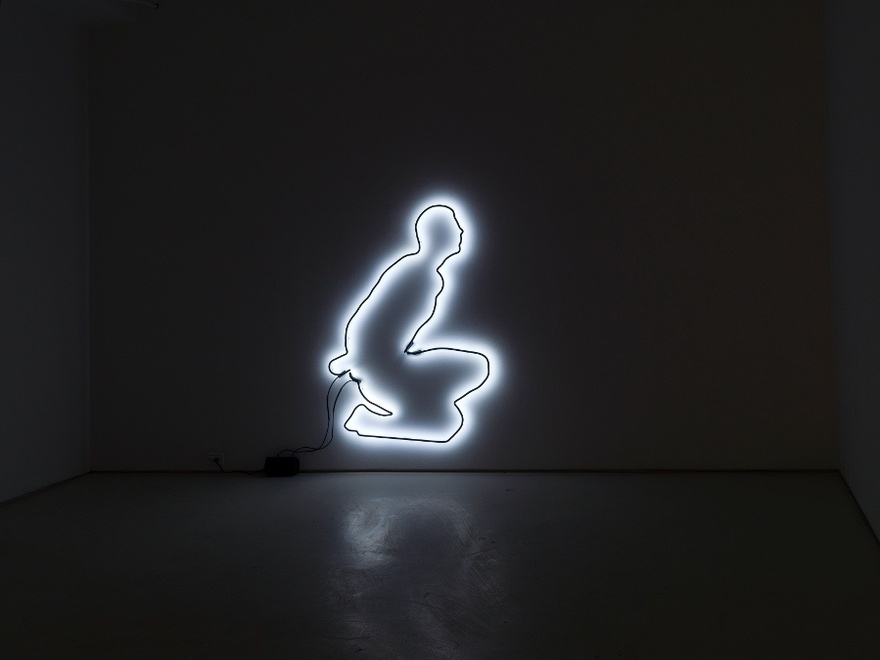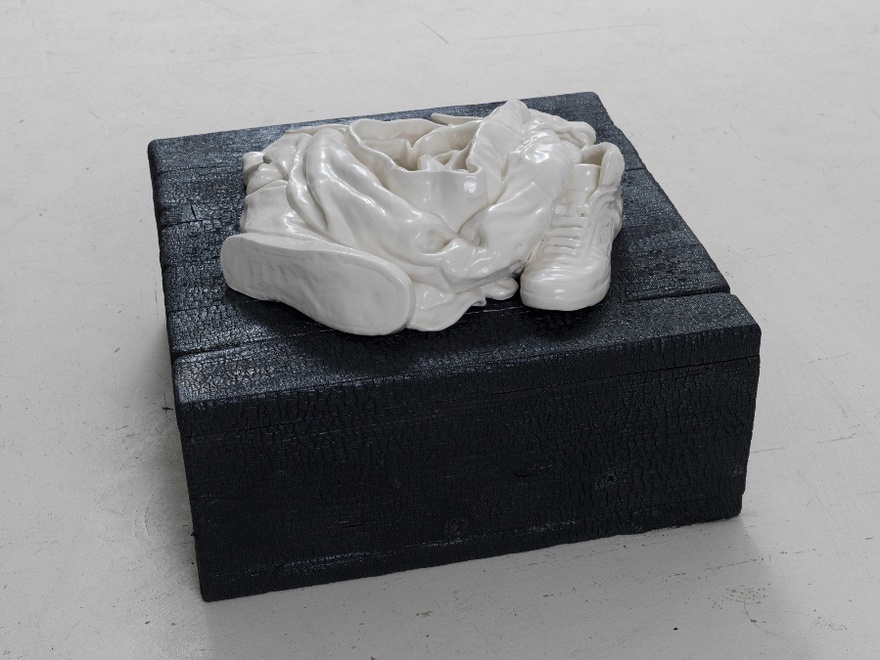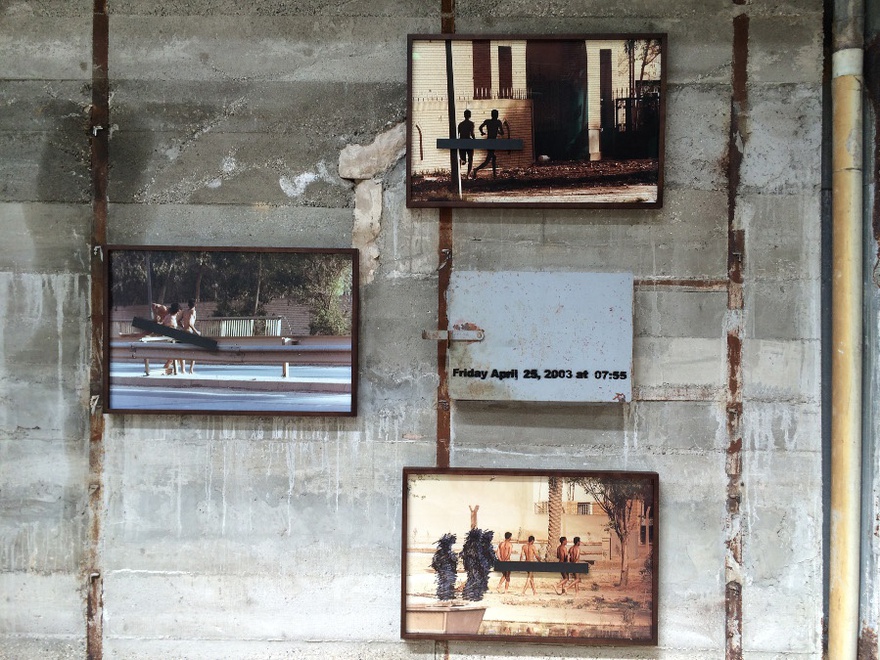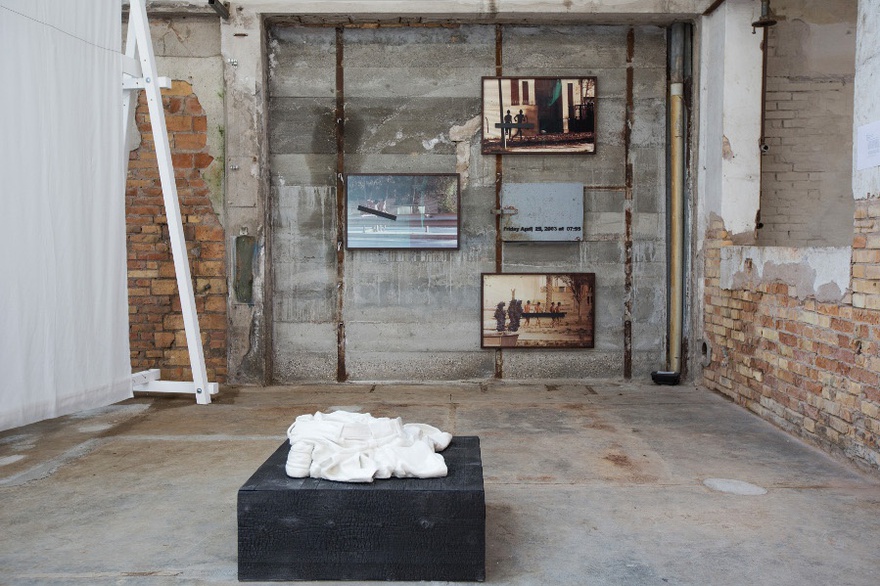Interviews
Action Piece
Reza Aramesh in conversation with Lara Atallah
While Reza Aramesh isn't a performance artist in essence, there is an inherent performative quality to his work. Known for a practice that looks into images of violence and the viewers' relationship to them, Aramesh has been creating bodies of work titled and numbered as 'Actions', according to events that took place at specific times in war torn areas. In this interview, Reza Aramesh discusses his 'Action' works in the context of archiving human suffering, highlighting the importance of questioning fiction and reality through his usage of the archive. Aramesh discusses the role played by the venues in which his works are displayed and how that reassigns the role of the audience; the ways in which he uses the human body as the location of the 'Actions' he creates; as well as his interest in the problematics of the 'truth', the gaze and voyeuristic practices.
Lara Atallah: Last time we spoke, back in 2013, you had a multi-venue installation entitled 12 Midnight displayed in five of New York City's most renowned nightclubs – such as The Bossa Nova Civic Club in Bushwick as well as Marquee in Chelsea – consisting of statues of martyrs, which commented on the human condition and its perpetual acts of violence. The project paid homage to seventeenth century Spanish polychromes and eighteenth century German Baroque sculptor Andrea Schluter. At the time, the site-specific nature of this project turned the audience into an active and necessary component of the work. The people who were dancing around each statue – whether they had noticed the statues around them or not – were automatically turned into active performers. The artwork didn't merely consist of the statues; rather it was about the audience's rapport with the statues within the larger context of a club.
Your latest exhibition Friday April 25, 2003 at 07:55, which was on view at the Leila Heller Gallery in New York this spring, is very different in that sense as it is conceived for the gallery space. It comments on an event that took place in Iraq where two Norwegian journalists Line Fransson and Tomm Christiansen happened to be driving by the Zawra Park in Baghdad at the beginning of the American invasion of Iraq only to see American soldiers escorting four naked Iraqi men across an open field. Using the photographs shot by Christiansen as a starting point, you have built an entire project comprising 3D images and porcelain sculptures that has culminated in an exhibition. With this most recent body of work the emphasis is on the archival images. The display includes framed pieces in which 3D silhouettes of a kneeling man are filled with archival images of war and suffering. How did you curate the content of your silhouette pieces in these most recent 'Actions' and what role did you have in mind for your audience?
Reza Aramesh: The location where an artwork is displayed plays an active role in defining the work. The artwork becomes both the piece and the space. I had another site-specific installation called The Whistle of the Souls, a play that never starts (2014) in Dubai, in March-April 2014. The title was taken from Saadallah Wannous's 1967–1968 play An Entertainment Evening for June 5th, which is set in the context of the post-1967 Israeli-Arab war. The whole play is about government officials and citizens who are invited to a play that never starts. Inspired by that work, I've created marble sculptures such as Action 137: 6:45pm, 3 May 2012, Ramla (2014) as a tribute to the under-appreciated workers in labour camps in the Emirates. The work was displayed in a warehouse between the labour camp and the Dubai Industrial Space.
The audience has a different relationship with the work depending on the venue. If we are to consider a gallery, we have to bear in mind the fact that it is a commercial space – this changes the way the work comes across. I think the spaces where the works are shown contribute to their meaning. With these recent actions in Friday April 25, 2003 at 07:55, I was working with the juxtaposition of images and while I'm in the process I don't necessarily know what drives me to choose the images I end up working with. To be frank, I like not knowing. Otherwise, the result of the work would end up being very didactic and illustrative. In a sense, you're putting images together and you're experimenting with a certain iconography. That said, the collages of the silhouetted man aren't completely deliberate. You can see in one of the pieces, for instance, the branch of a tree acting as a blindfold. The collage –- whether I'm using images of nature, or images that come from other zones of conflict – is used to create a bodily structure.
LA: Most of the pieces you've produced throughout your career are numbered and titled 'Actions'. The characters you depict are always in the midst of performing something. What is your definition of an action?
RA: In my mind, an action is something that is positive. It implies taking action and not being a passive subject matter. It stands for producing art that is hopefully not another useless artefact. I started calling my pieces 'Actions' at the time when I started reconstructing images of displacement and violence such as with the project Them Who Dwell on the Earth (2011), which consisted of seven sculptures displayed at One Marylebone in London with pieces such as Action 124: Bauchi, Northern Nigeria. Sunday July 27, 2009 (2011). The word also refers to the moment you take a photograph. The moment you press the shutter, you have taken action. But also, an action is defined by standing up for something, protesting against something, vocalizing certain issues and wanting to be heard.
LA: I like this idea of action referring to the moment when the shutter of the camera is pressed and a photograph is made. In that sense, your work is almost a tribute to all the photographers who have performed the action of taking photographs – the very images that you subsequently utilize to create work. Given the content of your work, which explores violence and our relation to it, is the idea of titling and numbering your pieces 'Action' a way to empower your figures such as, for instance, the kneeling man posture titled Action 143-1 (2015) in Friday April 25, 2003 at 07:55? What is the reason behind this cataloguing?
RA: Yes, in some ways. When it comes to the numbering of each action, I knew I wanted to do this as I didn't want my pieces to be untitled – I felt that would be too easy. I wanted to express the responsibility I have as an artist to make responsible art, whatever that means. I didn't want these pieces to be passive objects and I wanted the act of viewing to be an active experience.
LA: Would you say that through those 'Actions' you're creating an anthology of suffering that are framed by these figures?
RA: To me, it is more about questioning the idea of fiction and reality. I'm questioning what reality means. When we look at these images of conflict zones, what are we seeing exactly? How is reality defined within that context? Whose reality are we looking at? It also becomes about questioning the framing of these photographs, whether by the photographer or the media outlets, and acknowledging their subjectivity. These pieces are more of a way of looking at archives and fictions and challenging the role photography plays in telling the truth.
In the last couple of years, I've been wondering more about this idea of truth and reality, which I wanted to tackle in my work. This is even evident in some of my earlier works, where I recreate war imagery in palaces such as Action 108: Palestinians wait to cross the Erez Crossing whilst trying to flee from Gaza, 20 June 2007 (2012) where I recreated a press image of the events in Gaza but from inside the Chateau de Versailles. The only link these recreations had to the actual event was in their title such as, for instance: 'Group of Palestinians Crossing Gaza Strip'. Once you read the title, you have a sense of what was being reconstructed and staged as a performed action. The image was recreated using people I had met in my daily life who had agreed to partake in the project and I had them pose in the exact same way as the people who are pictured in the original press image. Essentially it was about juxtaposing opulence and violence.
The pieces for Friday April 25, 2003 at 07:55 are in a sense less reconstructed. By choosing palaces in my previous works, I was focusing on architecture playing a paramount role in how we interpret these reconstructed pieces of reportage. In this current project, I've started to move away from these reconstructions by going straight to the archival imagery. With these recent 'Actions', the body becomes the location of the event.
LA: I'd like to also talk about your porcelain sculptures for a moment, such as Action 146: Friday April 25, 2003 at 07:55 (2015), which you show in your latest exhibition at Leila Heller Gallery. You normally represent busts and human faces, but with this project you've moved away from the figural and decided to represent the four prisoner's shoes and crumpled clothes. Knowing that the clothes were burned in real life right before the men were escorted naked across the field, you've monumentalized the one thing that is unseen from that story. What made you decide to elevate the remains of that – let's call it shame-parade – performance?
RA: Looking more at that story, I became interested in how the clothes became a symbol to both parties. To the American soldiers, the clothes were convenient weapons that they could destroy with the aim of stripping men of their dignity. To the Iraqi men, the clothes were their shield that protected their intimacy and self-respect. If you think about it, these guys didn't get physically punished in a way that harmed their lives. It was the act of taking the clothes off and burning them that I found myself drawn to. The act of burning has a lot of different associations depending on the cultural context you're examining it in. In certain cultures, the act of burning is seen as an act of purification that helps deal with grief. I was drawn to idea of imagining this pile of clothes. While the photographs taken by the journalist present at the scene allowed me to see the characters and the landscape, the only thing I didn't have were their clothes. I enjoyed the idea that that element of fiction was left up to my imagination.
LA: You've materialized fiction by turning the burnt clothes into a very tangible, physical artefact, much like sculptures of Greek deities that were believed to exist in ancient Greece and yet were never seen by anyone. By hand sculpting the clothes out of porcelain and elevating them on a charred wooden plinth, you've made the one missing element from the story exist – it is a massive contradiction in a way.
RA: My work always comes with massive contradictions. On the one hand I'm looking at suffering and on the other I'm beautifying it. It's precisely about looking at violence in a way that one can come to accept it. Maybe if we accept violence as an inherent part of our existence, we'll start looking at it differently. With these pieces I wanted to memorialize what had been turned into ashes. I didn't want my sculptures to be marble or wood – I chose porcelain for its unpredictable behaviour during the process of firing, which is impossible to completely control. It makes the material collapse and it worked well for me because I didn't wish for these clothes to look perfect and untouched.
LA: Another striking particularity of Friday April 25, 2003 at 07:55 is that while throughout your career you've mostly created work centred around Middle Eastern subjects living in the western world, this time you've built your project around a photograph taken at the beginning of the Iraq war. I know that you always talk about your work in relation to Christian iconography but I feel that in this particular project it's hard to overlook the idea of gaze. The starting point of this project were the photographs taken by Tomm Christiansen – in many ways, we are following Christiansen's gaze.
RA: Yes, you're totally right. There's definitely this idea of gaze and voyeurism in the relationship that we have to violence. Are we just voyeurs for the sake of being voyeurs? The project questions the issues that we have with our bodies and how in certain cultural contexts, the body is used as a source of humiliation. I've been looking at the representation of violence going all the way back to the Greek civilization and I can't help but ask myself whether it's something that is inherent to us, whether it's something we need as part of our survival. The work becomes more about looking at the aesthetic of violence.
The local population told these soldiers that the worst thing you could do to Iraqi men was to strip them naked and get rid of their clothes by burning them. In this instance, violence is perpetrated through humiliation. The way we view our bodies is socially constructed. Different cultures treat the body in different ways. The Sufis believe that in order for someone to free themselves from the constraints of social structures, they must shed their clothes and walk naked in a local area while people point out your madness. If that person manages to survive that experience, so to speak, then they have transcended humanity and the material world. As you can see, this is very much in contrast to this project – there are so many elements to work with.
LA: Even more interesting is the fact that the event you've built your latest exhibition around is narrated by Line Fransson, one of the journalists present at the scene around which you've built this body of work. Fransson is the one who spoke directly to these men, in an attempt to understand what was going on and it is through her narrative in the exhibition catalogue that we find out the story behind the photographs, which problematizes the event further. It brings me to my next point – it's hard not to notice the absence of women in your work. You document suffering and you talk about iconography but the subjects you represent are always male.
RA: The representation of a woman's body or face has so many layers of historical associations. I somehow think that the male body is less complicated. The use of the male figure helps communicate the idea of the work in a much easier manner than by adding additional layers of complexity. I worked with women in my very early photographic work but I felt it was taking away from the piece. Consider the work of Rainer Werner Fassbinder: his films are highly dramatic and while he keeps his dialogues very simple, the presence of strong female characters makes you see and experience the intensity of the drama in that story. It's what makes his films so interesting. However, his male characters don't have any space. They always appear as backdrops or subfigures. His leads are always female and they have multiple personalities. In the case of my work, considering the vastness of the themes I'm exploring, it's more straightforward to use the male figure as an archetype. It allows the viewer to better see the subject matter.
LA: What role does gender play in your projects?
RA: I get this question often. First of all, I believe gender is constructed. As Judith Butler argues: gender is defined by the repetition of acts and codes of behaviour over a period of time. So I don't see gender as something that is clearly defined. Whether I'm using the male or the female figure as an icon is an archetype that masks the reality of what gender is. Certain attributions of certain behaviours might constitute a code that we might call masculine or feminine. In that sense, it is really difficult for me to differentiate these roles. But using male figures allows me to simplify the work. To me, the aesthetic of violence is the text and the figure framing it is the subtext.
LA: What drew you to the aesthetics of violence?
RA: Firstly, I have a desire to put forth the fact that the aesthetic of violence is not abstract and, secondly, I want to show that it is not a clear-cut line between good and evil, which is an inherent debate, especially in Christianity. It is a lot more complex than that. What I'm proposing with my work is that there is something within us that is drawn to violence, more so than we are willing to accept. Moral institutions have categorized violence as explicitly evil and yet, as humans, we encounter and perpetrate violence in different ways all the time. It made me wonder whether violence is a disease or whether it is something deeper than that, something that is imbedded in us. Neuroscience still knows very little about our psyche. My work isn't trying to be didactic or trying to provide an answer. It is a proposition that I'm putting forth to my viewer. That is my responsibility as an artist. The work I make isn't just defined by me, rather it is defined by the viewers and all those who encounter it. That is what defines an artwork.
LA: How do people in the Middle Eastern region react to your work?
RA: That always depends on who's writing about the work and what their background is. As far as I know, the work is more often than not appreciated. I can tell you about encounters I've had with people in my everyday life whom I try to seek out for my restaged pieces. I remember this one guy I met at my local swimming pool and he sent me a text the following day expressing his appreciation for being approached to pose for my work but that because of his religious affiliations he could not take part. He said that he really appreciated the work and was taken by it. He said he could relate to it. It was nice to get praise from someone who is very religious regardless of his unwillingness to participate.
As it happens though, the fact that my work is about the Middle East is because that is currently the biggest conflict zone in the world. Different moments in history have seen unrest in different parts of the world. The fact that I'm working with that region isn't so much because I'm Iranian. Sure, there's an affinity that I have with that region but at the same time, as an artist, I am simply considering events taking place in the present and the work that I want to communicate concerns issues in this lifetime.
Reza Aramesh was born in Iran, and has lived abroad since he was a teenager. He completed an MA in Fine Art from Goldsmiths University, London, in 1997. He has exhibited worldwide including the UK, France, China, USA, Dubai and Israel. He has orchestrated a number of performances and exhibitions in established institutions including the Barbican Centre, Tate Britain and ICA, London. Other projects have been staged in public squares, night clubs and industrial warehouses.



















